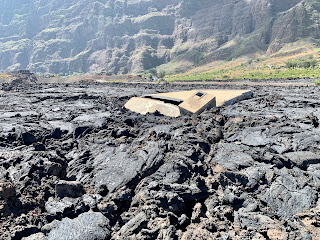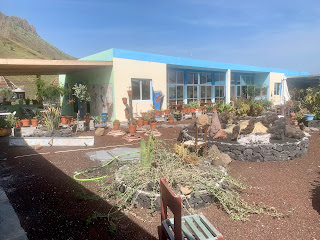1st - 4th Nov 2024
 |
| The National Flag on the Plateau in Praia beside a seemingly deserted barracks. The flight (ATR 72-500 again) from the basic, with few facilities, 'airstrip' on Fogo back to Praia was quick and uneventful. Left: Just behind the flag (above) and parked/dumped outside what seemed to be an empty military barracks was this armoured vehicle (My adviser in OMPITA will probably identify it?). It obviously requires a bit of overdue maintenance (which my adviser is well qualified to carry out). OMPITA has come up trumps (forgive the pun) again. That dilapidated vehicle is a 1960s era Russian amphibious BRDM-2 I spent a bit of time, again, wandering around the Plateau area which is about the only 'tourist friendly' area of the city, apart from some decent restaurants and bars down at the port/seafront area. It boasts some quite respectable shops, cafés and bars albeit infested with many irritating hawkers, peddlers and often just shouty 'loonies' who prey on Western tourists like me as we try quietly to sip our Super-Boc beers etc. One bar/Café of note is the Sophia Café, a pleasant venue, which has good WiFi and slow service. Right: A lass with quite an impressive hair-do at the café Casa das Salores, which was near my accommodation and which I visited for breakfasts (bacon, egg and kachupa) on occasions. A decent place. On Saturday afternoons and Sundays nearly all shops are closed. There are some museums but these seemed to be permanently closed. On Sunday, I was at a loose end and my host suggested that I visited the town/village of Cidade Velha which is on the coast about 10 miles west of Praia. It has an interesting history. I copy below a potted history of the islands to give perspective: The Cape Verde archipelago was uninhabited until the 15th century, when Portuguese explorers discovered and colonised the islands, thus establishing the first European settlement in the tropics. Because the Cape Verde islands were conveniently located to play a role in the Atlantic slave trade, Cape Verde became economically prosperous during the 16th and 17th centuries, attracting merchants, privateers, and pirates. It declined economically in the 19th century after the suppression of the Atlantic slave trade by the British Empire, and many of its inhabitants emigrated during that period. However, Cape Verde gradually recovered economically by becoming an important commercial center and useful stopover point along major shipping routes. Cape Verde became independent in 1975. The Portuguese discovered and colonised Cape Verde in 1446. They landed at Cidade Velha and built a large fortress there, on the high ground to the north, as well as many churches and other historic buildings. Cidade Velha became, at the time, effectively the capital of Cape Verde. It suffered, and repelled, attacks by both the British and French over the following centuries until, in 1712, the French attacked, captured and destroyed the fortress. I'm not sure how long they stayed. The walls were reconstructed by a Spanish company in 1999 and since 2009 it has been designated a Unesco World Heritage Site. I travelled to the village in one of the ubiquitous 'Aluguer' or 'IAS' mini-buses which you jump on or off at any of their stops. Cost to any destination on their route is CVE 200 Escudos (about £1.50p). I think they have about 20 seats and, at times, many more passengers packed in like sardines!  Right: Today Cidade Velha is now just a small seaside village with all the previous 'grand' buildings in the hills behind it in ruins. The local map shows 'ruins of' on many locations. Right: Today Cidade Velha is now just a small seaside village with all the previous 'grand' buildings in the hills behind it in ruins. The local map shows 'ruins of' on many locations.Left: I had a light lunch at one of the two bars/cafés on the beach. There were several Western tourists there and I got chatting with an elderly, and amusing, couple from Switzerland. We decided we would go our separate ways to visit the sights up on the hills behind. The map in my guide book was somewhat vague, so I just followed my nose, onwards and upwards, with the objective of reaching the 'reconstructed' old fortress at the top of the hills behind the village. Wandering up through the residential area I passed 'the ruins of' the old Cathedral (right). The path up to the hill-top was steep with many very high steps. It was hot. It was quite an exhausting climb. Left: Looking back down on the village from somewhere above. On finally reaching the fortress, phew!, there is a tourist information room where you are encouraged to watch a short video describing its history and pay for a CVE 500 Escudo (about £4) 'pass' to enter the walls. Right: the Fortress walls surrounding.....not very much apart from a circular dome covering an empty deep cellar. Right: Cannon (unmounted) overlooking the village and sea to the south. On the long walk down I passed the Swiss couple (met earlier at the seafront) who had 'nearly' made it to the top but the lady's footwear was not up to it and they had retreated. We found a small café, elaborately curtained with sea-shells, on the track about halfway down where we all stopped for a much needed glass of fizzy water. There was not much else to see or do, except for a bit of re-hydration at the seafront café. I bought a souvenir bag and a fridge magnet. I caught an 'Aluguer' mini-bus back to Praia. It dumped us all at the large Sunday open-air market somewhere in Praia (forgot to get a photo of this sadly). I subsequently became completely lost and had to find a taxi to take me back to my accommodation in Palmarejo district. I don't have much more to report and my flight back home left Praia (Nelson Mandela) at 1325hrs the next day. My small corkscrew was confiscated at 'security'. This is second time I have had a small corkscrew confiscated. I really cannot believe they pose a serious danger to anyone, but they are on the 'banned' list'. Can you imagine threatening anyone with the cry "Take me to Cuba, I am armed with a corkscrew and I'm not afraid to use it!". You could do more harm with the disposable cutlery they give you on the aircraft. It was a tiring journey. Praia to Lisbon 2hrs15mins. A 2hr hold-over in Lisbon before a '30 minutes delayed' 4hr30mins flight to London Heathrow arriving at 2350 hrs (L). I spent the rest of the night slumped at a Costa Coffee bar in the terminal and caught the Heathrow Express train to Paddington railway station at 0520hrs and another wait until my train left for my home town at 0705. I got back home at 0845hrs. A bit knackered. It had been a most interesting and enjoyable trip. PS. 1. I miscalculated my cash withdrawals/expenditure in Cape Verde. I have about CVE 2500 Escudos left over (about £20), which, I found out, are not exchangeable in UK. If anyone reading this is thinking of visiting Cape Verde please leave a comment to get in touch and I will sell them at a most advantageous rate! 2. My host in Cape Verde is keen to rent out her luxurious apartment with all mod-cons at a competitive price (£40pn) to anyone (will accommodate a family of four) who wants to stay in Praia. Again, leave a comment with contact info if you are interested. It has a very pleasant roof top terrace with good views (left). PPS. Sitting across the aisle from me on the flight from Lisbon to London was an incredibly 'large' woman. She could or would not walk and had to be pushed in a wheelchair around the airport and to the aircraft. How they got her into and out of her seat is a mystery. She was so fat she could not lower her tray from the seat in front. That did not stop her from ordering a very large packet of crisps followed by a full (expensive) airline meal which she greedily devoured in seconds. I think it was her small husband (maybe carer?) sitting next to her. He looked rather miserable, as did she. At what point......I say no more! And they complain and reject your cabin baggage if it is 1lb overweight. |





































